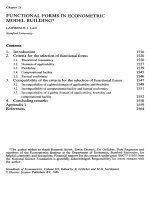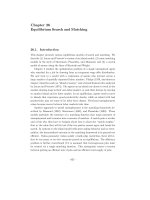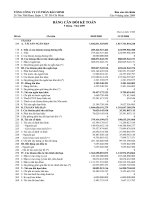Lecture Visual programming: Chapter 26 - Muhammad Bilal Zafar - TRƯỜNG CÁN BỘ QUẢN LÝ GIÁO DỤC THÀNH PHỐ HỒ CHÍ MINH
Bạn đang xem bản rút gọn của tài liệu. Xem và tải ngay bản đầy đủ của tài liệu tại đây (65.67 KB, 10 trang )
<span class='text_page_counter'>(1)</span><div class='page_container' data-page=1></div>
<span class='text_page_counter'>(2)</span><div class='page_container' data-page=2>
<b>Overview </b>
<b>of</b>
</div>
<span class='text_page_counter'>(3)</span><div class='page_container' data-page=3>
Over View
• Windows Programming
– WinMain()
• Where execution of the program begins and basic
program initialization is carried out.
– WndProc()
• Called by Windows to process messages for the
application.
• Contains the larger portion of code deals in responding
to messages caused by user input of one kind or
another.
</div>
<span class='text_page_counter'>(4)</span><div class='page_container' data-page=4>
Over View..
• 1st we have to define the type of window we
want to create.
– Windows defines a special struct type
<b>WNDCLASSEX</b>
</div>
<span class='text_page_counter'>(5)</span><div class='page_container' data-page=5>
WNDCLASSEX
<b>struct WNDCLASSEX</b>
<b>{</b> <b>UINT cbSize; </b> <b>// Size of this object in bytes</b>
<b>UINT style; </b> <b>// Window style</b>
<b>WNDPROC lpfnWndProc; // Pointer to message processing </b>
<b>function</b>
<b>int cbClsExtra; </b> <b>// Extra bytes after the window class</b>
<b>int cbWndExtra; </b> <b>// Extra bytes after the window instance</b>
<b>HINSTANCE hInstance; </b> <b>// The application instance handle</b>
<b>HICON hIcon; </b> <b>// The application icon</b>
<b>HCURSOR hCursor; </b> <b>// The window cursor</b>
<b>HBRUSH hbrBackground; // The brush defining the background color</b>
<b>LPCTSTR lpszMenuName; // A pointer to the name of the menu </b>
<b>LPCTSTR lpszClassName; // A pointer to the class name</b>
<b>HICON hIconSm; // A small icon associated with the window</b>
<b>};</b>
</div>
<span class='text_page_counter'>(6)</span><div class='page_container' data-page=6>
Over View…
• 2nd step is to tell Windows about our defined
structure.
• This is done using the Windows API function
RegisterClassEx()
<b>RegisterClassEx(&WindowClass);</b>
</div>
<span class='text_page_counter'>(7)</span><div class='page_container' data-page=7>
Over View…
• Each instance of the application must make
sure that it registers the window classes that it
needs.
• CreateWindow() function is now used for
creating a window whom characteristics are
already known.
</div>
<span class='text_page_counter'>(8)</span><div class='page_container' data-page=8>
Over View…
• The last task that WinMain() needs to do is dealing with the
messages that Windows may have queued for our application.
– 2 kinds of Win messages
• Queued Messages
– <sub>Windows places in a queue and </sub><sub>WinMain()</sub><sub> function extract these </sub>
messages from the queue for processing.
– The code in WinMain() that does this is called the message loop.
</div>
<span class='text_page_counter'>(9)</span><div class='page_container' data-page=9>
Over View…
• Non - Queued Messages
– There are non - queued messages that result in the WndProc()
function being called directly by Windows.
– <sub>A lot of the non - queued messages arise as a consequence of </sub>
processing queued messages.
</div>
<span class='text_page_counter'>(10)</span><div class='page_container' data-page=10>
Over View…
• Message Processing
• WinMain() contained nothing that was application - specific beyond
the general appearance of the application window.
• WndProc()
– Windows calls this function each time a message
for your main application window is dispatched.
</div>
<!--links-->









